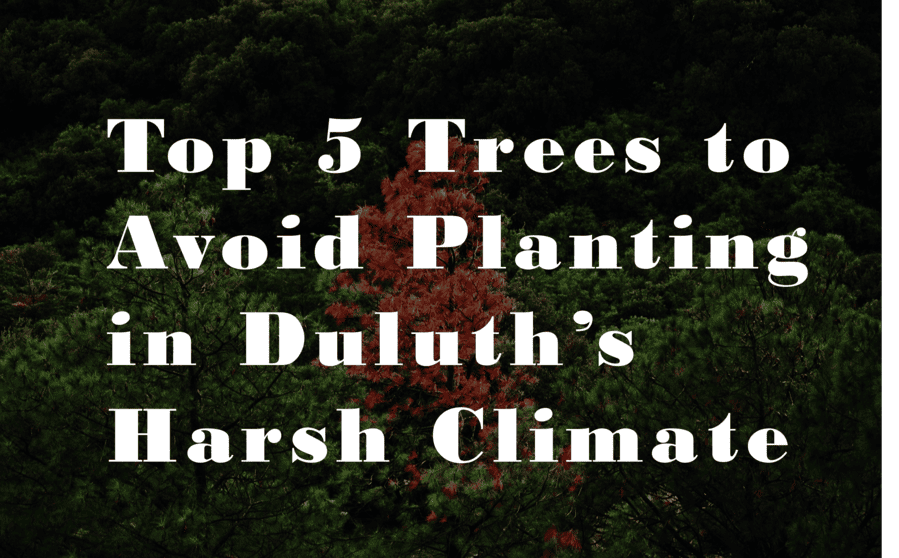If you’re considering planting new trees on your property in Duluth, MN, it’s important to choose tree species that thrive in our unique climate. Duluth is known for its cold winters, short growing seasons, and occasional heavy snowfall. While planting trees is a great way to improve your landscape, choosing the wrong species can lead to frustration, costly maintenance, or even tree failure.
In this blog post, we’ll highlight the top five trees that you should avoid planting in Duluth’s harsh climate. By understanding the challenges that these trees face in our region, you can make better, more informed decisions for your yard.
Contact for all Tree Service in Duluth Mn
1. Southern Magnolia (Magnolia grandiflora)
The Southern Magnolia is a beautiful evergreen tree that can be found growing in warmer regions of the U.S. However, it’s a poor choice for Duluth’s cold winters.
Why it doesn’t thrive in Duluth:
- Winter Hardiness: The Southern Magnolia is hardy only in USDA zones 7-9, and Duluth falls in USDA zone 3b. This means that the Southern Magnolia struggles to survive the harsh temperatures of a Duluth winter, which can dip as low as -30°F (-34°C).
- Cold Sensitivity: During winter, the Southern Magnolia can suffer severe damage to its leaves and branches, and often fails to bloom properly.
Alternative: Consider planting a Serviceberry (Amelanchier), which is hardy to zone 3 and provides beautiful spring blooms, fall color, and adaptability to Duluth’s conditions.
2. Japanese Maple (Acer palmatum)
Japanese Maples are known for their striking foliage and delicate, architectural shape. They thrive in warmer climates, making them another poor choice for Duluth.
Why it doesn’t thrive in Duluth:
- Cold Sensitivity: Japanese Maples are hardy only in USDA zones 5-8, and Duluth’s extreme winters often leave these trees vulnerable to frost damage. Japanese Maples have thin bark and tender buds that don’t tolerate freezing temperatures.
- Winter Dieback: They can suffer dieback during the winter months when temperatures drop too low. In severe winters, Japanese Maples may not even survive.
Alternative: Try planting a Red Maple (Acer rubrum), a native tree that is incredibly hardy (zones 3-9) and can handle Duluth’s frigid temperatures. Plus, Red Maples offer brilliant red fall color!
3. Tulip Tree (Liriodendron tulipifera)
The Tulip Tree is a fast-growing, large tree known for its striking flowers and tall stature. However, this species is native to the warmer southeastern U.S., and it doesn’t handle Duluth’s conditions well.
Why it doesn’t thrive in Duluth:
- Winter Hardiness: The Tulip Tree is hardy only to USDA zones 4-9, meaning it’s barely able to survive Duluth’s harsh winter temperatures. These trees are susceptible to cold damage in the northern climates.
- Weak Wood: Even when it does survive, the wood of the Tulip Tree is relatively soft, and it’s prone to breakage during heavy snowfalls or windstorms.
Alternative: Consider a White Birch (Betula papyrifera), which is not only cold-hardy (zone 3), but also provides stunning white bark and is well-suited to Duluth’s snowy winters.
4. Lombardy Poplar (Populus nigra)
Lombardy Poplars are a fast-growing tree that provides quick shade and a columnar shape, making them an attractive option for landscaping. However, these trees have significant drawbacks when planted in Duluth.
Why it doesn’t thrive in Duluth:
- Short Lifespan: While they grow quickly, Lombardy Poplars have a very short lifespan of around 10-20 years. They are prone to disease and structural weaknesses, often leading to early death in harsh climates.
- Root Issues: The tree’s roots are shallow and invasive, which can cause problems with nearby structures, sidewalks, or utility lines. In Duluth’s heavy clay soil, these trees often struggle to grow healthily.
Alternative: Try planting a Northern Red Oak (Quercus rubra), which is hardy to zone 3 and provides long-lasting beauty, strong wood, and resistance to most pests and diseases.
5. Black Walnut (Juglans nigra)
Black Walnuts are valued for their hardwood and nuts, but this tree can be a poor choice for residential landscapes in Duluth. While it’s hardy in zones 4-9, it faces challenges in colder climates.
Why it doesn’t thrive in Duluth:
- Cold Damage: The Black Walnut is vulnerable to cold temperatures, especially when young. Late spring frosts or early fall freezes can damage the tree’s buds and leaves, leading to poor growth and nut production.
- Allelopathic Properties: Black Walnuts produce a chemical called juglone, which inhibits the growth of many other plants. This can make landscaping around the tree very difficult.
Alternative: Consider planting a Northern White Cedar (Thuja occidentalis), a hardy evergreen that can handle extreme cold and offers dense foliage year-round.
Choose Wisely for Duluth’s Climate
When planting trees in Duluth, it’s essential to consider not only the beauty of the tree but also its ability to thrive in our cold and sometimes unforgiving climate. Choosing the wrong tree can lead to costly maintenance, tree damage, and even removal. By avoiding species that aren’t suited for Duluth’s USDA zone (3b), you’ll ensure that your landscape remains healthy, beautiful, and low-maintenance for years to come.
If you need help selecting the best trees for your property or if you’re unsure about the suitability of your existing trees, don’t hesitate to contact our tree experts. We’re here to help you choose trees that will stand strong through every Duluth winter!

